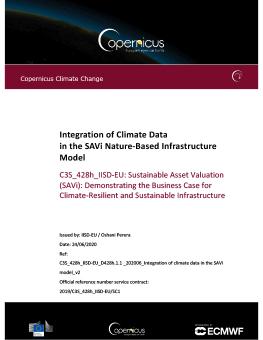
Integration of Climate Data in the SAVi Nature-Based Infrastructure Model
C3S_428h_IISD-EU: Sustainable Asset Valuation (SAVi): Demonstrating the Business Case for Climate-Resilient and Sustainable Infrastructure
This report outlines the integration of authoritative Copernicus Climate Data from the Climate Data Store (CDS) into a Sustainable Asset Valuation (SAVi) of nature-based infrastructure. It describes how several climate indicators obtained from the Copernicus CDS were integrated into the SAVi Nature-Based Infrastructure model and how its analysis has improved as a result. In light of this integration, IISD can generate sophisticated SAVi-derived analyses on the costs of climate-related risks and climate-related externalities.
This document presents:
- A summary of the literature review on the climate impact on nature-based infrastructure, including equations that link climate variables to the performance of nature-based infrastructure.
- How the above information was used to select relevant indicators from the Copernicus database.
- How outputs of the CDS datasets are integrated into the SAVi System Dynamics (SD) Nature-Based Infrastructure model.
- How simulation results can be affected using this new and improved set of indicators.
You might also be interested in
What’s Next After UNEA-6: Why “synergies” is more than a buzzword
In an era marked by escalating environmental challenges and geopolitical tension, the Sixth United Nations Environment Assembly (UNEA-6) called for more cooperation to tackle the triple planetary crisis.
UNFCCC Submissions Tracker
Tracking and sharing opportunities for stakeholders to give input to the UN climate change negotiations.
The State of Global Environmental Governance 2023
In global environmental talks in 2023, the focus across nearly all issue areas was funding implementation and reviewing performance.
A Sustainable Asset Valuation of the FAME II policy in India
This report presents the economic valuation of the second phase of the Faster Adoption and Manufacturing of Electric (& Hybrid) Vehicles (FAME II) policy in India and demonstrates its economic, social, and environmental outcomes under different scenarios.